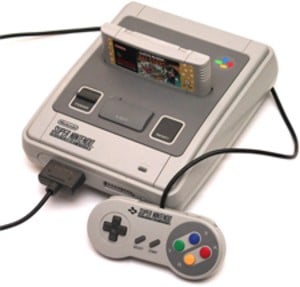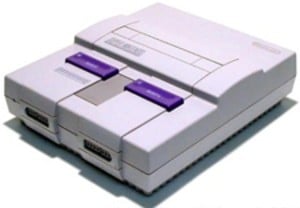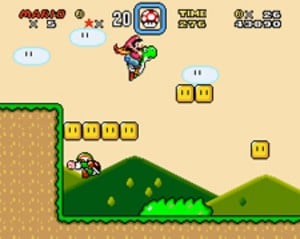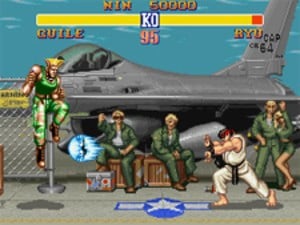
Though Nintendo's domination of the 8-bit era - attained through a combination of the company's business acumen in entering the market when most other were hesitant at best and the practices employed post-success to ensure the monopolistic domination of said market - had, in terms of units sold, been their most successful, the 16-bit era brought with it a marked move away from the videogame practices of earlier generations, both in terms of market dynamics and the nature of the games produced. Previously, the huge hardware gap between home consoles and arcade machines, not to mention the limited storage and audio-visual capabilities of machines like the Atari 2600 and even the NES itself had severely limited the style of games that could be successfully designed and programmed. It is perhaps from this early stage that the even now extant focus of most Japanese developers on the actual gameplay of games, as defined primarily by their controls and the 'feel' of playing (as intangible as this was and is) arises. The 16-bit generation was perhaps the most significant in shaping the long-term identity of home video games versus their arcade counterparts, and it would not be erroneous to claim that the Super Nintendo Entertainment System was the console that defined, and benefited from, this paradigm shift.
Arcade games had long been held as the standard to which home games were compared. Even Nintendo themselves had, prior to their entry into the home market, been primarily recognised for arcade games like Donkey Kong. The limitations in porting these games, with their often dedicated hardware set-ups, to a generic platform like the NES, and the success with which this had been achieved (compromises notwithstanding), was an early and important factor in the sales success of both the NES and its software. 8-bit games, including even those that had no real arcade counterpart, were often reliant on the same type of quick-fix gameplay and emphasis on skill and practice that defined arcade cabinets.

Early experiments in creating games that outgrew these roots had not been unsuccessful (notably series like Zelda and Final Fantasy), but the vast majority of the games of the NES era fit this template; often, games were placed within a genre - be it platform or racing or any other - simply because this is what the hardware allowed to be done well. Though Sega had been the first hardware manufacturer to release a 16-bit machine with the Mega Drive/Genesis, that company's role as primarily a creator of arcade games had in and of itself limited the scope of much of the early releases for the system, most of which were ports of already-famous coin-ops by Sega's famous design studios, primarily Yu Suzuki's AM2.
Nintendo, on the other hand, seemed to immediately have a grasp of the differentiation needed to succeed in the face of competition that had simply not existed during the previous generation. Though it was the last of the 16-bit consoles to be released (the TurboGrafx-16 and Mega Drive had both been on the market for several years), the SNES was immediately and extremely successful. Designed as a true successor and superior to the NES (and arguably the competition) from a technological standpoint, its impact on release in Japan on November 21 1991 was such that the ensuing mayhem caused the police to ask for future console releases to be scheduled on weekends to minimise disturbances.

Nintendo laid down a marker for the quality expected of developers immediately; Super Mario World, bundled with the system, was not only immediately recognised as one of the greatest games ever made, but also demonstrated, with its emphasis on saving and continuing games at a later time, that home games could be seen as longer-term endeavours than their arcade counterparts, games not only to be enjoyed on an immediate basis, but to be explored over a number of gameplay sessions.
Previous games had implemented these very ideas, but never so successfully, and never within the envelope of a platformer, a genre Nintendo themselves had defined with Super Mario Bros. as being amenable to an immediate fix. The retention of a scoring system, as redundant as it was, might cynically be viewed as a nod to the previous generation's games. However, the statement had been made with admirable efficacy. The continued support Nintendo enjoyed from third-party publishers and developers also ensured the success of the SNES. By the time the machine was released in Europe in April 1992 (having seen a blockier fashioned redesign for the North American market and an equally successful release there 8 months prior), a number of era-defining games were already released or about to be released, chief among them Zelda: A Link To The Past and Street Fighter II, each a representative of what could be done with the machine.

While Zelda: A Link To The Past essentially defined the Zelda games, gaining little except for inspiration from the earlier games and expanding their scope monumentally, SFII was an example of a current arcade game being more faithfully ported to a current system than most people thought possible. The dropping prices of memory at this time, compared to the rather strict limitations of the previous generation, also aided developers. Companies like Square followed suit, and expanded on their ideas from the NES era to produce perhaps the greatest entries in the Final Fantasy franchise, IV, V and VI.
The SNES was also innovative in the sense of its hardware: while the CPU ran at a slower clock frequency than that of the Mega Drive (a fact reiterated by Sega repeatedly in their attempts to portray it as an inferior machine in their marketing), both its graphics hardware and sound hardware were quite a step above. Most famous of all the SNES's graphical tricks, perhaps, was the famed 'Mode 7', which allowed tiled 2D sprites to be rotated and zoomed in a manner that simulated 3D. The effect was used effectively from the very beginning in games like Pilotwings and F-Zero, and came to exemplify the perceived graphical prowess of the machine.

Later incorporation of the so-called SuperFX chip into cartridges also brought genuine polygonal 3D, as limited as it was, to games like StarFox, and the chip was used to great effect, though subtly, in the original Yoshi's Island, a game which together with the Donkey Kong Country games, kept the SNES relevant in the face of competition from Sega's new Saturn and Sony's PlayStation, itself a product of a failed collaboration between Sony and Nintendo to produce a CD add-on for the SNES called the Play Station.
The facts remain, however; Nintendo would never enjoy the sort of domination in the gaming market as it did with the SNES, a fact discussed elsewhere on this site. But it might be prudent, in these days of value-for-money concepts in videogaming defined by the number of hours one derives from a game, that the SNES was the console on which many of these ideas were fleshed out.
Maybe more importantly, its early games remain perhaps the first than can be enjoyed today without nostalgia tainting one's impression of their actual quality, the experience of playing them often as magical as when the games were first released; Nintendo itself seems to acknowledge this with the numerous direct ports it has released for newer handheld consoles of SNES games. Not for nothing is this machine remembered as one of, if not the, greatest consoles of all time.


Comments 32
Great article! A really good read. I've always thought the USA snes was a really nice looking console.
One point you did not really get across is this: This console is the holy grail of console RPG gaming. Almost all modern console RPG's can trace their origins to this system.
Greatest System ever made.
You can say that again Veszerin
The games on this console were phenomenal!
I loved Mario World and DK Country, and only a few years ago got into Zelda a Link to the Past and FF!
I remember being impressed by the SuperFx Visuals, as if a small step into the future of gaming! XD
Hooray for Square!
It's some times that articles like this are becoming more frequent, this is a feature that our friends at GiGa TV probably missed, as they are comouflaged among the other news. They missed some pearls....
When you read tons of articles about one of the most influent machines of video gaming, it's great to come across some considerations and aspects that keep you interested in reading.
I like how the 16bit machines expanded the -litelarally- gamefield of gaming experience. There were starting to exist games that were more like a toy to be exploited by oneself curiosity; the 16bit era (and where I live it was AMIGA that was the coolest thing) provided new (mind)places to be explored firstly to the designers then to the players.
A very good reading.
Excellent article.
The SNES was the first system I owned as a kid. Through the years it was home to Super Mario World (My first game!), Super Metroid, Killer Instinct, Donkey Kong Country, and so many others along the way. I even remember when I got the Super Scope for my birthday one year lol. Good stuff.
Yes, I do enjoy these articles, though there were a few unwieldy and redundant sentences; I write like that too sometimes! Good read.
I grew up with the N64, and as much as I would like to say it's the best, it lacked the 3rd party support and it had too many lackluster games to top this one (which I did eventually buy for twelve US dollars!). I could go on all day about ocarina and Mario 64, but A Link To the Past and Super Mario World are just about as good, if not better.
the USA SNES looked really good, IMO.
Personally think the USA SNES design, controllers and cartridges are horrible and no-where near as good looking as the PAL/Japanese version.
I love snes, I have always toyed with the idea of buying one, especally for mario paint. That would handle a dream on the classic controller!
who cares about how it looked, it was the best console ever.
Zelda: LttP, Secret of Mana, Seiken Densetsu 3, Final Fantasy II & III(IV and VI), Illusion of Gaia(Time), Act Raiser, Chrono Trigger, Earthbound, Super Mario RPG, Donkey Kong Country, Super Mario World, And numerous amazing games I never got the chance to play.
I know I haven't listed all the great games on the SNES, These are simply the ones i've had the chance to play.
I had both a Genesis and a SNES "back in the day".
Aside from Phantasy Star IV and Popfulmail (sp? a Platformer/RPG for Sega CD), the bulk of my console gaming hours were spent with my SNES.
I was always a bit ticked... in Final Fantasy 3, I had ten times the cash needed to get the airship piece during the auction sequence.... and the game wouldn't even let me bid! ARGH!!! Oh well, all that cash was just a side-effect from a glitch that resulted from me saving and quiting during a near power outage at my house.
But I'll still always have a soft-spot for Popfulmail, still have the disc for it..... "I'm Mail! POPfulmail!".... That game was so cute.
my snes still works.i dont use it because the wii invaded my brain.snes was the first console i bought with my own money...oh what great memories playing super batter up overnight with my friends! 1992...sniff
SNES, the greatest system made. Love the article. However, I feel the Turbo Grafx/Duo is a d@mn close second place. The TG-16 games are one of the reasons I got a Wii.
"Though Sega had been the first hardware manufacturer to release a 16-bit machine with the Mega Drive/Genesis, that company's role as primarily a creator of arcade games had in and of itself limited the scope of much of the early releases for the system, most of which were ports of already-famous coin-ops by Sega's famous design studios, primarily Yu Suzuki's AM2."
Actually I think that's what sold the system early on. What limited it was the lack of third party support to make new quality titles, Sega were nearly on their own in the first year or so.
"Maybe more importantly, its early games remain perhaps the first than can be enjoyed today without nostalgia tainting one's impression of their actual quality, the experience of playing them often as magical as when the games were first released;"
Wat are you basing this on? I mean people still play and love Tetris and it keeps getting new fans.
Christmas '92 will be long remembered thanks to PAL SNES!
I like the North American SNES better then the PAL and Japenese version. Maybe though its because I owned it as a kid, and it is what I am used to.
The SNES I got for my 6th birthday, and was the first counsel I ever owned. Such fond memories of SMW, and DKC.
Very nice article too.
The games were so expensive; costing far more than an entire Game Boy for a single cart.
You get what you pay for, 2097
Loved this thing. I remember my brother saved enough money to buy it just as it was being released. After school I ran across the playground to get to my parents car, who were picking us up to take us to Toys R Us. My best friend came along for the ride- too this bad boy home and spent all night playing through Super Mario World. That was one of the coolest, most exciting moments of my childhood. I love this system.
I really wish that I was born a little while before this console was released back in the days, because I'm aware of all the 16-bit greatness I've missed, especially the RPGs. But still, I've played many of the SNES best games on the GBA though.
Awesome article!
Most games started here or on the NES. LOL
The NES was a revolution compared to the Atari 7800 that it replaced (on my shelf, anyway), and the SNES itself a revolution compared to the NES. Alright, sure, I was limited by my parents' willingness to spend money on videogames, but honestly, I didn't own a Genesis because I felt I didn't need to. The NES was simply awesome all the way through its life, especially with games like Mario 3 that I could play over and over again without boredom.
But oh, did the magic happen the first time we fired up that new SNES. I don't think I've ever felt quite as blown away as I did the first time I saw the beautiful graphics of SMW or the vivid colors and enormous sprites of Joe and Mac. When I experienced the SNES, I almost instantly understood the gameplay limitations that had been imposed by the lesser hardware of the 8-bit machines that I had never noticed before.
Personally, I've always disliked the style of the US machine and when I first saw the Japanese console, I lusted after its sleekness. I never really understood why Nintendo changed the design, because the US design is a lot more clumsy and irregular, but I suppose they wanted to visually highlight the fact that games from different countries weren't meant to be played in US machines.
Perhaps I'm becoming a jaded old fogey (I'm not that old, but I did start out with a Pong machine), but I've never felt quite the same magic with a new console since. There has been some high points: PSX ushers in 3D games, Dreamcast becomes one hell of a glorious finale for Sega as a console manufacturer, Halo drops my jaw more than once, and some current games' attention to detail really impresses me. But nothing can match the magic of the SNES era, or even the NES era for that matter. It's not nostalgia, it's great gameplay from a time before controllers started including a million buttons and analog sticks, when games were easy to jump into (to be fair, some really great games have been made that would be difficult or impossible to play with such simplistic controls... try playing an FPS on Dreamcast, for instance).
Maybe I'm just stubborn, or maybe I'm losing interest in gaming, but complex control schemes (and definitely anything that requires configuring before playing) turn me off. This is one of the reasons I was attracted to the Wii, and sure enough, there are some great games for it too, but not much that I'm totally raving about (but then again, I haven't bought any games in a while, as lately I've been playing some classic adventure games on the PC). I use the Wii for VC much more than anything else.
So, I don't know, but for me, the SNES was the pinnacle of gaming. Perhaps because it was so good, the Nintendo 64's "failure" was that much harder to swallow (wasn't so much of a failure, but a disappointment, and a failure to live up to the hype that was generated), but Nintendo seems to have lost some of the magic from the SNES days. I think part of the reason why retro gaming is so popular is because it's so easy to get into. And you can have just as much fun (often even more fun, depending on the games) with older, "simpler" games. I think the SNES pretty much capped off the era of gaming where you could have loads of gameplay without overly complicating things for casual players.
Contra III, anyone?
I remember when the gaming magazines were all about the Genesis and the TurboGrafx-16. I remember the cover of Video Games and Computer Entertainment looked like the SNES was a drawbridge into a castle. I remember staring intently at screenshots of giant Bullet Bills in some level of Super Mario World. I remember when my brother-in-law got his SNES. We stayed up all night playing Super Mario World. I remember loving the controllers. I also remember about two years later, he sold his SNES and got a Genesis. Why? Because he wanted to play Sonic Spinball. Yes. Sonic Spinball.
i had a super nintendo that broke, it was my first game system and i loved it so much. i missed the good super nintendo days until recently and now i have all my games back
SNES was my first game system. It is my favorite system of all time. Games Like DKC2, the Lion King, Ceasars Palace, Virtual Bart, Mario Kart and so on, is the reason i am as fascinated with video games as i am today.
I miss my Super Nintendo that I remember games!
I did prefer the American console design. Granted, I am American, but I prefered the color scheme for the Japanese and European controllers. I had an ASCII select auto-fire controller that I used which had the Japanese colors on the buttons. Both it and my SNES still function to this day and get occassional use.
Super NES Forever
Tap here to load 32 comments
Leave A Comment
Hold on there, you need to login to post a comment...